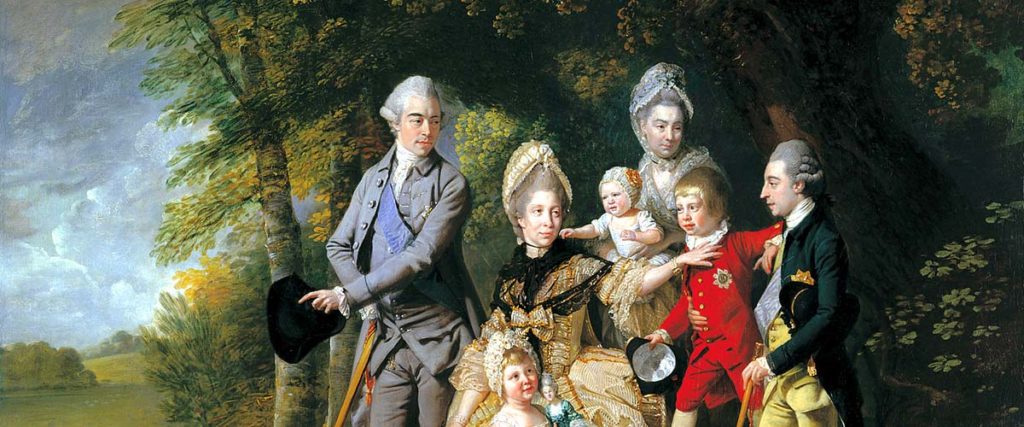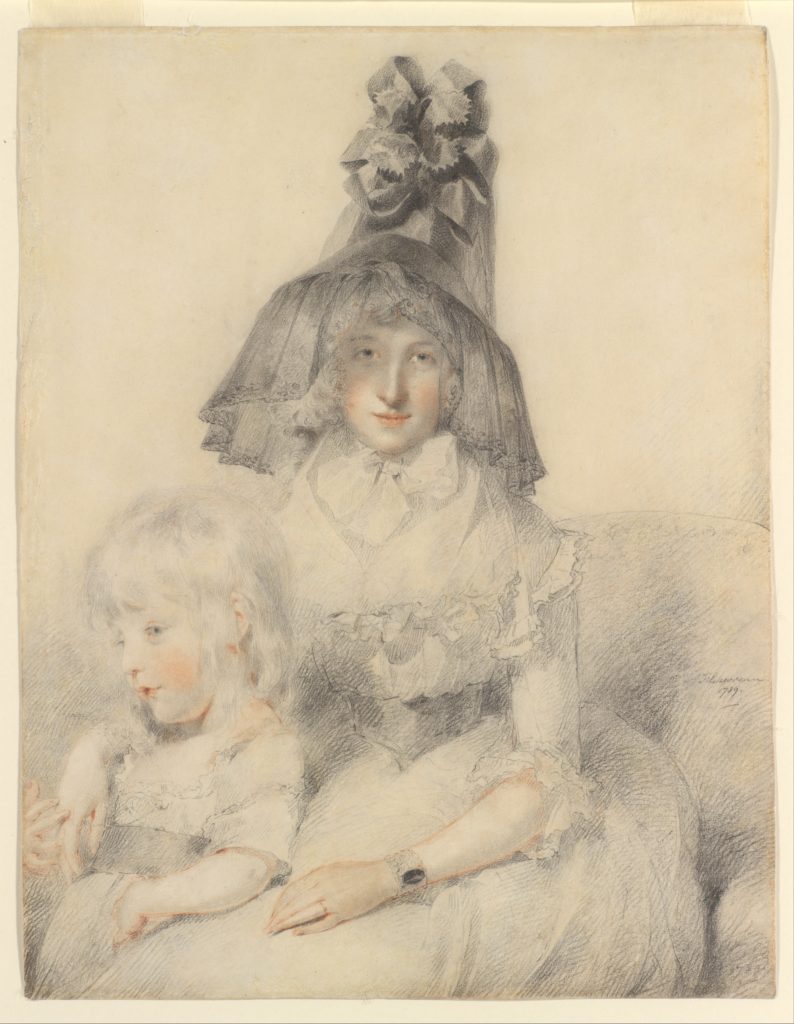In God’s Hands: Inoculating the Royal Children against Smallpox
In the second of our postings linked to the first release of medical materials among the Georgian Papers, Helen Esfandiary of King’s College London considers inoculation in the royal family.

‘Queen Charlotte (1744-1818) with members of her family’, Johan Zoffany, 1771-72; Royal Collection Trust 401004: the picture includes Ernest duke of Mecklenburg to left, Lady Charlotte Finch holding the baby, and Prince William in red
The involvement of the Hanoverian Court in helping to popularize smallpox inoculation is well documented — Caroline of Ansbach (1683-1737, wife of George II) when Princess of Wales spearheaded the very first trials in England in 1722, and Queen Charlotte, wife of George III, continued her unwavering support of the practice despite losing her sons Alfred (1780-1782) and Octavius (1779-1783) to it. Notwithstanding the part civic duty doubtless played in obligating these royal figureheads to embrace the technique for the public good, just how difficult a decision might it have been on a more personal level to expose one’s child to such a dangerous and uncertain procedure? Recently digitized material in the Georgian Papers among the material relating to Queen Charlotte affords a valuable insight into this process.
Unlike the much safer practice of Jennerian vaccination which was developed at the beginning of the nineteenth century, inoculation carried significant risk and uncertainty. It entailed taking infected matter from the pustule of a smallpox sufferer and placing it under the skin of a healthy individual to create a local infection and a mild form of the disease — thereby conferring life-long immunity against what might otherwise be a virulent and fatal case. But the procedure did not always work: sometimes it led to a full-blown and potentially fatal case of smallpox; sometimes it simply did not ‘take,’ in which case it had to be repeated; and sometimes it resulted in such a mild form of the disease that one could never be quite sure whether future immunity had been achieved.
All these scenarios occurred under Queen Charlotte’s watch, yet none of them perturbed her sufficiently to prevent her from remaining steadfastly in favour of the practice throughout her life. A relatively fleeting account of the inoculations of Princes Augustus (born 1773) and Ernest (born 1771) in a letter from Queen Charlotte to royal governess Lady Charlotte Finch written on 7 October 1775 (GEO/ADD/15/8157), provides a fascinating insight into what ultimately underpinned her decision to inoculate her children against smallpox: her faith in ‘Providence’ to see them through their procedure. In this letter Charlotte writes:
“I have the pleasure to acquaint you that my dear Children underwent their Operation with all possible and more than expected for Heroism, I trust that same Providence which has hitherto given me uncommon success in all my undertakings, will not withhold it from me at this time, as I can say with great truth it is not begun without Praying for his assistance as the greatest and best of Medicines I can put my Confidence in.”
Even in the enlightened climate of the eighteenth century, medicine still operated on a providential basis. Inoculation may have offered the potential to manage the severity of smallpox, and as such it represented a medical breakthrough for its time, but whether it worked or not was still believed to depend very much on God’s will. Charlotte clearly equated Providence with the workings of medicine, relying on it for the outcome of the process rather than on the medical procedure itself. And so, when it came to losing Alfred, it was with a genuine sense of resignation that she was able to say to her brother Charles, prince of Mecklenburg-Strelitz: “I am very grateful to Providence, that out of a family of fourteen children, it has never struck us except in this one instance, and so I must submit myself without a murmur.” [i]
Charlotte was known to have been particularly devout, and so perhaps her response is not surprising. Yet other mothers writing about inoculation in this period also demonstrated a continued reliance on Providence to see their children through the procedure and many other day-to-day perils; “it having pleased God” being the stock justification for any outcome of a critical nature. George concurred with his wife that Alfred’s death had been ordained. In a letter to Prince William he wrote that “It has pleased the all wise Director of all things to put a period to the life of dear little Alfred, who certainly was as fine a Child as ever was seen.” [ii] As undeniably stricken with grief as Charlotte and George were at the passing of Alfred, and would be at the passing of Octavius shortly thereafter, at no point in any of the correspondence surrounding these deaths is there any suggestion that Charlotte or George felt the need to atone for having had their children inoculated, or that they were inclined to lose faith in the procedure itself.

Mrs Papendiek and her son, by Sir Thomas Lawrence, 1789. Metropolitan Museum of Art
Indeed, Charlotte represents an excellent test case for the decision-making process around inoculation. Her beliefs about what smallpox and inoculation represented had already been put to the test on a number of occasions before she lost Alfred and Octavius to it. In 1768, Charlotte at one go had inoculations performed on her elder brother Duke Ernest of Mecklenburg (1742-1814), her son Prince William (born 1765), and Charlotte Louise Henrietta Albert (1765-1840, the daughter of Friedrich Albert, formerly in the service of the Mecklenburg court but who had accompanied Charlotte to England at the Queen’s insistence as her confidential attendant; Miss Albert had been brought up alongside the royal children, and later as Mrs Papendiek became a lady-in-waiting to the Queen). Miss Albert later described the inoculation as ‘two punctures in the arm near to each other … made with the point of a lancet, through which a thread [containing the diseased matter] was drawn several times under the skin, and this on both arms’. [iii] Seven years later, however, and despite having experienced a textbook case of mild smallpox at the time — convulsion, fever and inflamed pustules which rose and subsequently dried off regularly — Miss Albert nevertheless caught the smallpox in ‘full force’. For six weeks at least, she suffered the confluent sort where the pustules all ran together: “[N]o one could give me any comfort or alleviate pain. I could only be lifted by four people, one at each corner of the sheet, to have my bed made; for not a pin’s point could be placed between the pustules.” [iv]

William Bromfield. Coloured engraving by D. Orme, 1792, after R. Cosway. Wellcome Library@ Licence: CC-BY-NC
The discovery that Miss Albert’s inoculation had not rendered her immune to smallpox momentarily ‘shook’ the Queen’s confidence in William Bromfield (1713-1792), surgeon to her household, who had performed the operation, and who had assured everybody at the time that those inoculated “were secure from further fear of disease”. [v] Charlotte’s concern was no doubt driven by the fact that when the three had been inoculated, it had taken “no effect whatsoever” on her brother Ernest, and that William had become “less ill” than Miss Albert. [vi] Nevertheless, Charlotte’s fears were allayed when Bromfield reassured her that the children had been inoculated “from different subjects”. [vii] At any rate, her concern appeared to have been directed more towards Bromfield and his abilities as a surgeon, than towards inoculation itself.
The fact that Charlotte was appeased so readily suggests that she had an appreciation of the uncertainties surrounding the procedure. Indeed, this was not the first time her brother Ernest had been inoculated and it had not ‘taken’. A diary entry by regular visitor at court Lady Mary Coke (1726-1811) written a year prior to the three inoculations reveals that, “Ernest, the Queen’s Brother, has been inoculated twice in ten days, but nothing has come out, so they suppose he had had the small pox, tho’ he did not know it”. [viii] Presumably, the decisi0n had been taken to have Ernest inoculated yet again in case the belief that he had already had smallpox at some point was mistaken. And so, when she discovered that Miss Albert had not been rendered immune, Charlotte already had first-hand experience of the unpredictability of inoculation; it was certainly not enough to dissuade her from continuing to have the remainder of her children inoculated.
Trusting in Providence for the outcome of the procedure rather than the medical procedure itself meant that Charlotte simply did not weigh up the consequences of ‘naturally-’ versus ‘artificially- acquired’ smallpox in the way we would today. An appreciation of the very different conceptual footing on which Charlotte and George operated not only sheds light on why they continued to advocate inoculation after a number of failed attempts, and even death; it also explains why, publicly or privately, they never attributed their children’s deaths to inoculation per se.
NOTES
[i] Charlotte to her brother, 22 August 1782: British Library, London, MS Facsimile *953, ‘Charlotte, Queen Consort of George III: Letters to members of her family, chiefly to her brother Charles, Prince afterwards Grand Duke of Mecklenburg-Strelitz; 1780-1787’. Photocopies of originals from the Mecklenburgisches Landeshauptarchiv, Schwerin, held (1964) by the Staatliches Archivlager, Göttingen: 718-942, at 801. Author’s translation from the original French.
[ii] George III to Prince William, 4 September 1782. GEO/ADD/4/16
[iii] ‘Memoir of Charlotte Louise Henrietta Albert Papendiek’, 1833, in Court and Private Life in the Time of Queen Charlotte: Being the Journals of Mrs. Papendiek, Assistant Keeper of the Wardrobe and Reader, to Her Majesty, ed Mrs Vernon Delves Broughton, I (London, 1887), 42.
[iv] Ibid., 71.
[v] Ibid., 42.
[vi] Ibid.
[vii] Ibid., 71.
[viii] The Letters and Journals of Lady Mary Coke, II, ed. David Douglas (Edinburgh, 1889), 433, journal entry, December 1768.
Helen Esfandiary is a current postgraduate student in the department of History at King’s College London, and holds a Professor Sir Richard Trainor PhD Scholarship. She is working on a thesis entitled ‘Maternal Perspectives on the Preservation of Children’s Health and Well-Being in Eighteenth-Century Elite Society’.

Dear Mrs. Esfandiary, this was very interesting to read, maybe, it is of interest for you that the elder sister of Charlotte, Charles and Ernest seems to have had the smallpox as Thomas Nugent reports in his “Travels through Germany” that Princess Christiane was: “…a little marked with the small-pox.” (Letter XII, p. 355). Apart from that I would like to make the remark that the figure of Prince Ernest is not the taller and handsome man on the left side of the family group in the Zoffany painting. That is Charlottes brother Charles wearing the Order of Saint Andrews. The small and delicate man on the right side of the group wearing the black Justaucorps is Prince Ernest wearing the Order of the White Eagle. (Please see: The conservation piece – Scenes of a fashionable life, London, 2009, p. 116)
[…] Queen Caroline (the wife of George II and grandmother of George III), embraced inoculation in this blog post for the Georgian Papers Programme by researcher Helen Esfandiary. The post also includes links to […]